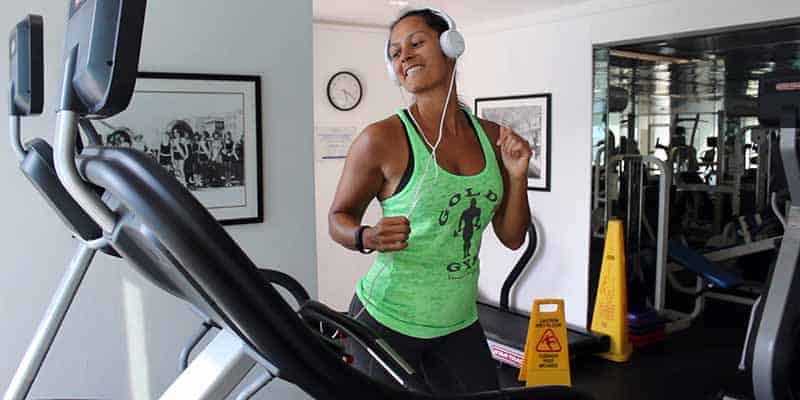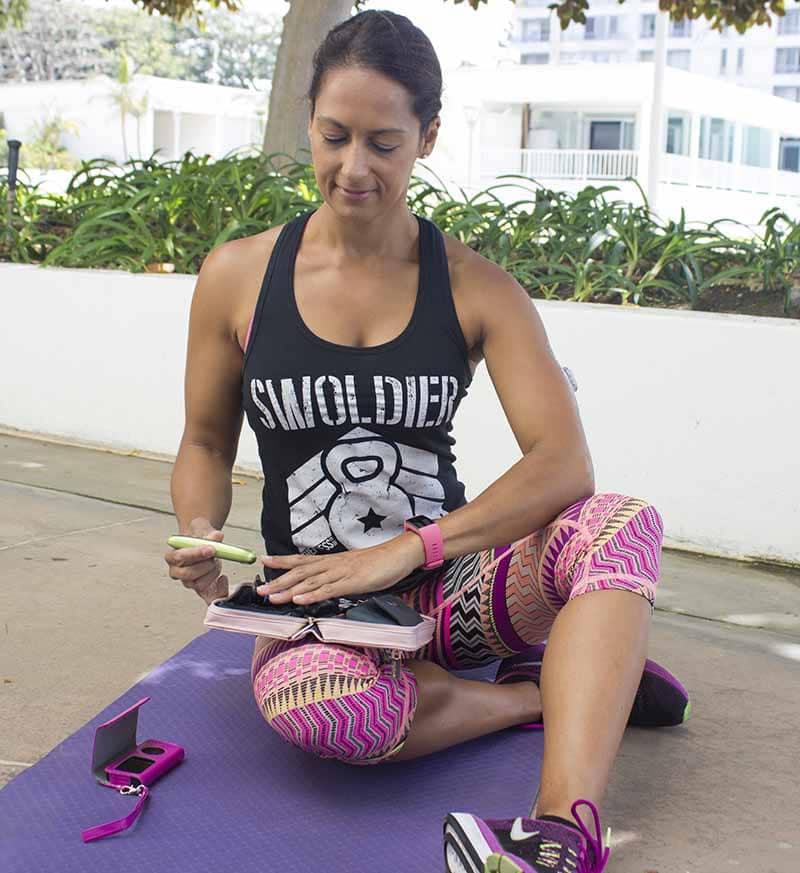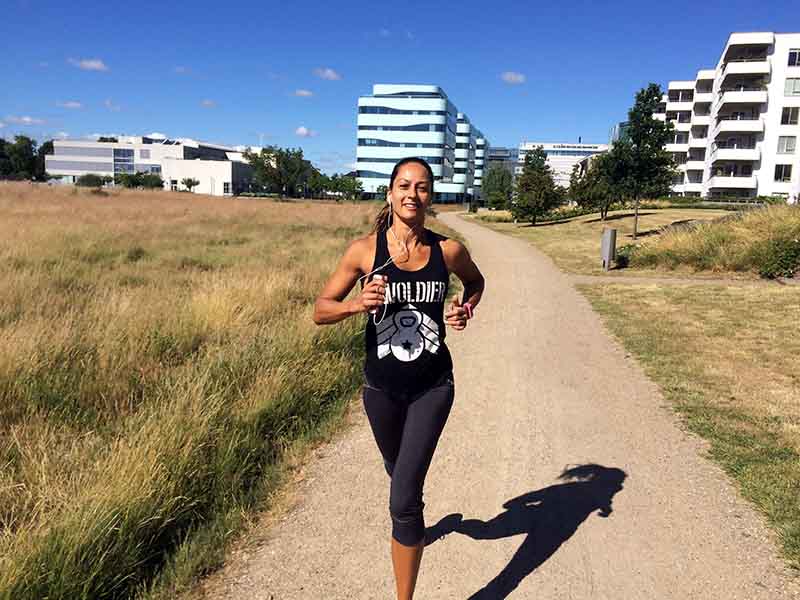Like most people with diabetes, I tend to have a love/hate relationship with cardio. I love all the positive things that cardio does for my body and diabetes management, but I hate how hard it can be to keep my blood sugars under control while working out.
At least I used to hate it before I found a formula for insulin and food around workouts that works for me (most of the time).
In this post, I’ll describe how you can find your own formula for success when it comes to cardio.
Why do cardio at all if it’s so hard?
Regular cardio workouts have so many benefits that they should always be included in your weekly workout schedule, regardless of your goals.
Cardio can help with weight management, improves insulin sensitivity, help you relax and sleep better, and improves your cardiac health. All great things!
The general guidelines state that healthy adults should engage in at least 150 minutes of exercise per week. That’s only 20 minutes of movement per day. It doesn’t have to be full-out “I think I’m going to die” cardio either. Just getting your heart rate elevated for this period of time is enough to reap most of the benefits.
Take me, for example – some of my favorite types of cardio are dancing, hiking, circuit training, walking the dog, and boxing. I recently gave spinning a try, and though I really wanted to love it, after 7 spinning classes I just had to admit that I didn’t enjoy it at all. So I won’t be doing that again anytime soon.
What I’m trying to say is that cardio can be challenging and fun at the same time, and you should choose a type of cardio that you enjoy!
Taming your blood sugars during and after cardio
When somebody with a functioning pancreas starts a cardio session, his or her body will reduce the amount of insulin released. The body is smart like that. However, those of us who take insulin have to be smart on behalf of our bodies and adjust our insulin when doing cardio.
What happens when you start a steady-state cardio session (meaning you’re not doing intervals but keeping your heart rate elevated and fairly stable) is that your insulin sensitivity increases. In other words, your body gets more efficient at using the insulin you’ve injected (can we all just agree that your body becoming more efficient is a good thing, please?).
This improved efficiency is why you will most likely need less insulin when adding cardio workouts to your weekly routine.
Yes, I said you’ll need less insulin!
This is one of the most important things that I teach all my diabetes coaching clients. If you are consistently experiencing lows during cardio (or in general), it’s generally better to reduce your insulin rather than increase your intake of carbs. This can mean a reduction in your bolus amounts, your basal amounts, or both.
If you try to fight lows by preemptively eating carbs, you are just “feeding the insulin”, which can be counterproductive, is more difficult to get right, and can make weight management much harder.
How much to adjust your insulin
The question then is when and how much to adjust your insulin. You don’t want to reduce it too much and have your blood sugars running high either.
Unfortunately, there is no easy formula that fits everyone, but if you track what you are doing and analyze your data, you can find your own formula for successful cardio and diabetes management. You can use my free Blood Glucose tracker (PDF or Excel) or make your own.
Note: While there isn’t a formula that fits all, there are some general guidelines that I highly recommend you take note of!
The three golden rules for gathering data:
- Reduce the number of variables – do the same exercise routine the first week or so. If you can also keep your active insulin on board when exercising the same, even better, but it’s not a requirement
- Measure, measure, measure – as a minimum you will have to measure your blood sugar before your workout, right after, and 60-90 minutes after
- Accept missteps – it’s most likely that you won’t get it right every time, and that’s OK. Keep glucose tabs around and learn from your mistakes
How to find your diabetes management formula
Let’s get to it. If you follow the three golden rules above, you should be able to start putting your formula together after as little as 2-3 cardio sessions.
What I want you to do is pretty simple. I want you to track your blood sugars religiously, following the same format as I have in my BG tracker. I’ve added an example in the tracker so that you can see what that would look like, and I’ll use that example here.
(I know it’s hard to read clearly here, but you can see a larger version if you click the image or download the tracker)
This example assumes I worked out Monday and Wednesday, doing cardio for 40 minutes in the evening on both days.
In this example, my assessment would be that I managed to get my insulin right on Monday, but that I had too much insulin in my system for the Wednesday session (I went low and had to drink juice).
The only reason why my blood sugar was acceptable 60 minutes after the workout Wednesday was due to the extra carbs I had during my workout, and that isn’t optimal management. I had to have that juice not because I was thirsty or craving juice, but because I needed to feed the insulin in my system, of which there was too much. That indicates that something has to change.
This is only two data points, but based on this, I would try to have less than 0.5 IU active insulin on board when starting a cardio session like the ones I did that week.
Note that the low blood sugar during the Wednesday workout could also be due to already declining sugars due to overdosing at dinner. That would be something I would have to test out as I continued to do more workouts.
What I did here was record my findings, make an initial analysis, and form a few hypotheses based on my findings (e.g. of a hypothesis is to not have more than 0.5 IU active insulin on board).
If you’re self-managed like me, you can then start making adjustments and test out your hypothesis. If you rely on your medical team for adjustments, this will be golden information to bring to them so you can make the changes together.
There are generally 3 things your hypothesis could be centered around when it comes to making insulin adjustments for cardio:
- mealtime bolus adjustments
- amount of active insulin on board during the workout
- basal adjustments
Please always be cautious when making changes to your diabetes management. If you feel that you need more data points before making any hypotheses or tweaks to your insulin doses (if this is new to you, I would definitely recommend a minimum of five data points), please do so.
If you don’t make insulin adjustments on your own but with your medical team, please bring them your data and continue to work with them.
No matter what, this is a process that takes time. You will have successes and missteps, but after a while, you will start to have a very good idea of how to adjust your insulin to get through a cardio workout safely and effectively!







Abdusslam
Hi Christel,
I am trying nowadays to create a program for count carbs and how can I increase or decrease the blood sugars by food .This means if I have 200 mg/l blood sugars how can I decrease this by eating some food .So I need formula for calculate blood sugars .Could you help me thanks
Christel Oerum
The only way to reduce your blood sugars is by having enough insulin in your body. You can improve how well that insulin works through exercise and other medication. So when you think of finding your formula I suggest you think about how you balance your blood sugars with insulin, exercise, and food
Josephine Spira
Hi Christel.
Thank you loads for your information on finding your formula, food exercise ( cardio) and insulin control. You’re the best and a star in my eyes for bringing out this subject so straight and simple to follow.
I have diabetes type2 and not on insulin injections. I do orals. I still know that l will tweak your worksheet to work for me. Its been tough on me regarding my highs and lows so your chart will definitely help much.
Problem over here is gps don’t appreciate patient participation, bringing charts to them etcetera, believe you me, they ‘ll propably say you’re trying to teach them thier job blah blah…but never mind that we’ve learnt take everything on board and get all the help we can get from guys like you for our own health sake. So thank you Christel for caring and sharing. Hoping to hear from you and hopefully good feedback from my end. Stay healthy.
Christel Oerum
Thank you, that’s incredibly kind of you to take the time to write. And you’re right, not all medical professionals are “partners” and will value participation. I’ve been there… One way of going about working with someone like that is letting them know that you’ve noticed A (like a rise in your morning BG) and that you’re wondering what to do about it, would it make sense to do B (increase your orals). Some are more receptive if it’s asked like a question. It’s frustrating that it has to be like that though, I hope you figure it out
Robb
How do you calculate Insulin on Board?
Christel Oerum
This question comes up a lot, so I think I need to write a full article on that soon. Until then you can see a visual + explanation on our Instagram page (Click here).
And this is the summary:
If you use a pump, the IOB will be listed. HOWEVER, that does not include the rapid-acting insulin (Humalog/Novolog) you’re given as basal, and I think that absolutely should be included as well. Why, because it still impacts your blood sugar.
This is how you can calculate your basal IOB (if you use an insulin pump) and you can use the same approach to calculate IOB from any injections you might have taken if you manage your diabetes with pens or syringes: Generally, rapid-acting insulin is assumed to last about 4 hours in the body (you might metabolize it quicker or faster though) so I generally focus on that time window. In this example, I’m assuming a basal rate of 1 IU per hour, but that’s just for simplicity, you’d want to look at what your basal rate actual was for the last 4 hours.
So to get to your basal IOB, you’d assume that:
1️⃣ 25% of the basal rate you got 4 hours ago is left in your system
2️⃣ 50% from 3 hours ago
3️⃣ 75% from 2 hours ago and
4️⃣ 100% from the last hour,
which in this case would add up to 2.5 IOB.
Any bolus you’d might have taken within the last 4 hours would have to be added to that. Like 2 IU taken 2 hours ago would mean your IOB was 2.5+2*50% = 3.5 IOB
Paula
I am so glad to find your site. I have been a type one diabetic for 37 years and I am approaching the big 50 next year.
I want to get in better shape and lose some lbs. In my area I don’t have any trainers who know how to help someone with T1D and beating the bulge.
I am looking to lose about 30 lbs and tone up. What would be the best approach, I haven’t done a regular exercise regime in several years and where and how to start is overwhelming.
Christel Oerum
Welcome to the site!
This is a great article to get you started and you can also read some of the exercises and type 1 diabetes posts. There’s also a tab with workout videos. Another resource is my Fit With Diabetes Ebook that you can find here: https://diabetesstrong.com/fit-with-diabetes/
Have fun!
Patsy Sightler
I am so thankful for having found your website. Even though I have been insulin dependent since 1984, I am always learning…especially since I am on the new pump that regulates basal rates. I have been on pump therapy since 1993…but at this stage of life (I’m 73), I am having difficulty losing weight. Exercise is my greatest challenge because of lows, immediately, as well as hours, after. I feel like I am running on a treadmill, getting nowhere because any type of activity causes my Bg to drop, resulting in more snacking! Once we are able to return to the gym (it has been closed because of the pandemic), I am definitely going to use your tracker to see if it helps. Any other recommendations would be greatly appreciated.
Christel Oerum
I’m so happy you found us too!
And I really agree that living with diabetes is a constant learning experience. I hope the sheet helps you and also remember to use your pumps exercise setting, maybe even starting it an hour before you start your workout
S Basava Kiran
Mam can you say name some simple exercises which prevents lower back spasms if it already comes. Which helps in keeping lower back muscle strong
Christel Oerum
The first step would be to see a specialist and determine why you have the back spasms. Depending on the diagnosis the specialist will prescribe the appropriate exercises